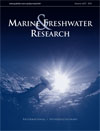Marine and Freshwater Research
Volume 63
Number 7 2012
Few stock assessments explicitly take account of spatiality owing to model complexity and the need for auxiliary information such as tagging data. We developed a population dynamics model that allows for spatial structure and integrates a novel data source derived from a habitat preference model. Spatial differences in abundance and seasonal migration patterns should be considered for incorporation into stock assessments for species that have preferred habitats.
Drought-breaking rains in late 2010 inundated the Barmah–Millewa Forest and resulted in a prolonged hypoxic blackwater event within the forest and the Murray River downstream. This study found that blackwater affected sites had higher abundances of emerged Murray crayfish, larger numbers of dead or dying smaller crustaceans and lower abundances of native fish (but similar abundances of alien fish) than non-affected sites. We discuss the potential longer-term significance of the event, research gaps and management options for reducing blackwater impacts.
The control of invasive species is a major challenge to the preservation of native ecosystems. In this study radio-telemetry was used to understand seasonal distribution of carp in relation to environmental parameters to guide efficient eradication strategies. The results have led to the eradication of carp from Lake Crescent and a significant reduction of their population in Lake Sorell.
Trout cod (Maccullochella maquariensis) are an endangered Australian freshwater fish which have undergone massive reductions in density and range since European settlement. This manuscript describes the success of a ten year conservation stocking program was undertaken in the Ovens River in south-eastern Australia. In particular, the results indicate the importance of long-term stocking regimes when reintroducing species to their former range.
Models are an indispensible part of fish stock management but how do you chose the 'right' one? This paper highlights the potential role for flexible machine learning approaches in fishery assessments where the "right" model complexity is part of the model fitting process, using reproductive and abundance estimation examples. The results show a potentially key role for such approaches in both data rich and poor settings.
The ability to predict macrophyte states and thresholds in estuaries are important when determining their freshwater allocation. This study used a 5 year dataset to determine a water level and salinity threshold for macrophyte states based on dominant species. It also determined available habitat based on a DEM, both important tools for the management of estuaries.
Centrostephanus rodgersii is new to New Zealand and its biology here is unknown. This study aims to provide the first estimates of growth of this species in New Zealand, and to increase our knowledge of its biology at this location. Modelled growth was slightly higher in New Zealand and annual recruitment seems to occur regularly.
Implementation of effective management for elasmobranchs is hindered by lack of appropriate scientific data on diet, life history, and behavior. This work shows how an emerging technique known as stable isotope analysis has been and can be used to generate data in support of science-based elasmobranch conservation and management. Examples of past research, recommendations for future work, and inherent limitations and assumptions in the method are described.
Zinc is a critical micronutrient in the open ocean; its trace concentration and susceptibility to contamination demands the utmost of analytical procedures. This review provides the latest critique on analysis, speciation, biological role and modelling of its cycling in seawater. Enhanced global observations of Zn in the oceans, coupled with validated new conceptual models, can reveal its part in regulating phytoplankton community structure and conceivably productivity.




